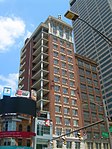Current (sculpture)
2023 establishments in Ohio2023 sculpturesColumbus, Ohio stubsColumbus Museum of ArtDowntown Columbus, Ohio ... and 4 more
Fabric sculpturesHigh Street (Columbus, Ohio)Outdoor sculptures in Columbus, OhioUnited States sculpture stubs
Current is a soft fiber sculpture by Janet Echelman, installed in Columbus, Ohio, United States. The work is suspended over High and Gay streets in Downtown Columbus. The sculpture was installed in May 2023. It is intended to represent the changing urban fabric of the city, and is situated around a large redevelopment by Jeff Edwards, who paid for the sculpture.
Excerpt from the Wikipedia article Current (sculpture) (License: CC BY-SA 3.0, Authors).Current (sculpture)
East Gay Street, Columbus
Geographical coordinates (GPS) Address Nearby Places Show on map
Geographical coordinates (GPS)
| Latitude | Longitude |
|---|---|
| N 39.963611111111 ° | E -83.000833333333 ° |
Address
The Citizens Building
East Gay Street 14
43215 Columbus
Ohio, United States
Open on Google Maps










